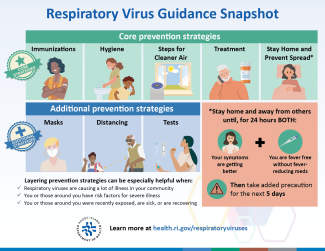COVID-19 Prevention

Core Prevention Strategies
The Centers for Disease Control and Prevention (CDC) recommends that all people use core prevention strategies to protect yourself and others from COVID-19 and other respiratory illnesses.
- Stay up to date with your vaccines
- Practice good hygiene by covering your coughs and sneezes, washing or sanitizing your hands often, and cleaning frequently touched surfaces
- Take steps for cleaner air to increase ventilation and circulation
- When you may have a respiratory virus:
- Use precautions to prevent spread. Stay home and away from others until your symptoms are getting better for 24 hours and you’re fever free without fever-reducing meds for 24 hours. Then take added precautions for the next 5 days.
- Seek health care right away for testing and/or treatment if you have risk factors for severe illness. Treatment may help lower your risk of severe illness.
Additional Prevention Strategies
You can choose from these additional prevention strategies to further protect yourself and others:
Key Times for Prevention
All of the prevention strategies described above can help reduce risk. They are especially helpful when:
- Respiratory viruses are causing a lot of illness in your community.
- You or the people around you were recently exposed to a respiratory virus, are sick, or are recovering.
- You or the people around you have risk factors for severe illness from respiratory viruses or certain medical conditions.
- You may not be aware of the things that can make others more vulnerable to serious illness. Using the core prevention strategies will provide some protection no matter what. If you are unsure about the health condition or risk status of those around you, the most protective option is choosing to use additional prevention strategies, like masking, physical distancing, and testing.